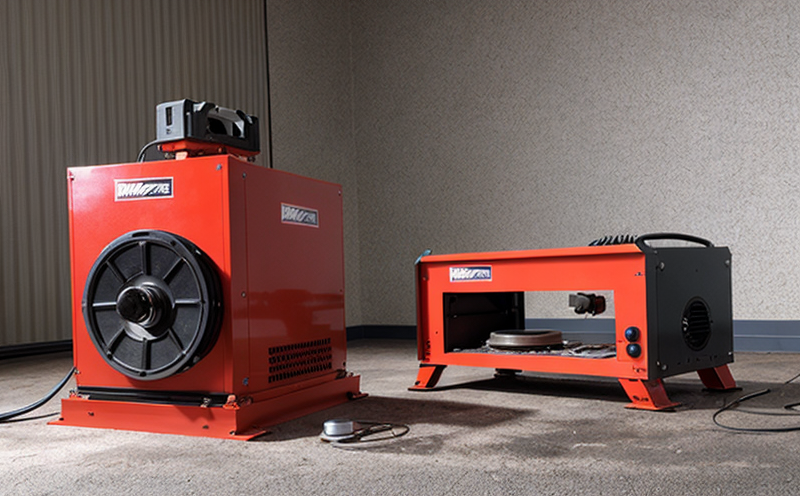ASTM D999 Random Vibration Durability Testing of Containers
The ASTM D999 random vibration durability test is a crucial procedure employed in the evaluation of containers used across various industries, including automotive, aerospace, and consumer goods. This testing method ensures that products withstand the dynamic stresses encountered during transportation and handling. The primary goal is to simulate real-world conditions that may lead to fatigue or failure, thereby enhancing product reliability and safety.
The test involves subjecting containers to random vibrations within a specified frequency range over a set duration. The frequency spectrum can vary depending on the type of container being tested; however, it typically spans from 5 Hz to 1000 Hz for most applications. Specimens are often mounted in different orientations to simulate various real-world scenarios.
During testing, containers undergo repeated stress cycles that mimic the dynamic loading they might experience during transport or use. The test aims to identify any potential weaknesses or vulnerabilities within the structure of the container before it reaches the market. By identifying these issues early on, manufacturers can make necessary adjustments and improvements, ensuring better performance and longevity.
One key aspect of ASTM D999 is its ability to assess not only the structural integrity but also the functional capabilities of containers under extreme conditions. This includes evaluating how well seals hold during shaking or whether components remain securely fastened despite rough handling. The test helps manufacturers ensure compliance with relevant industry standards such as ISO 2631-1, IEC 60455, and EN 1795.
Another important consideration is the environmental factors involved in this type of testing. Temperature variations, humidity levels, and other climatic conditions can significantly impact a container's performance during transportation and storage. ASTM D999 allows for controlled environmental chambers that simulate these external influences, ensuring accurate assessments regardless of local weather patterns.
| Parameter | Description |
|---|---|
| Vibration Frequency Range | 5 Hz to 1000 Hz (adjustable based on specimen type) |
| Vibration Amplitude | ±5 g RMS or ±12 g peak-to-peak, depending on application |
| Durability Time | Duration varies based on product specification but generally ranges from 24 to 72 hours |
The process begins with thorough preparation of the container samples, including cleaning and labeling them appropriately. Once prepared, containers are placed into a controlled environment where they will be subjected to precise vibration cycles designed to replicate their expected usage conditions.
After completion of the test, detailed analysis is conducted using various measurement tools and techniques provided by our laboratory experts. These analyses help determine whether or not the container has met all specified criteria outlined in ASTM D999. Results are compiled into comprehensive reports that include graphical representations of vibration spectra, statistical data on peak accelerations experienced during testing, and any observed changes to the physical properties of the specimen.
- This rigorous testing ensures higher levels of product quality.
- It promotes safer transportation practices by reducing risks associated with failures in containment systems.
Why It Matters
The importance of ASTM D999 cannot be overstated, especially given today's increasingly globalized supply chains. Containers are subjected to harsh environments during transport, which can lead to premature failure if not properly designed and tested beforehand. By adhering strictly to ASTM D999 guidelines, manufacturers can significantly reduce the likelihood of such failures occurring in service.
Furthermore, compliance with these standards demonstrates a commitment to safety and quality assurance that customers increasingly demand from suppliers. Meeting these requirements enhances brand reputation and fosters trust between stakeholders involved in product distribution networks.
Why Choose This Test
- Precise simulation of real-world conditions through controlled environmental chambers.
- Rigorous evaluation of both structural integrity and functional performance.
- Comprehensive reporting capabilities that provide detailed insights into test results.
Use Cases and Application Examples
The ASTM D999 random vibration durability test finds application in numerous industries where robust containers are essential. Automotive manufacturers, for instance, rely heavily on this testing method to ensure that their components are capable of withstanding the jarring forces encountered during road travel. Similarly, aerospace companies use it to verify that satellite parts and other high-value equipment can survive launch vibrations.
- Automotive component suppliers may employ ASTM D999 tests on fuel tanks or battery packs to guarantee they remain intact throughout shipment.
- Consumer goods manufacturers might apply this test to packaging materials intended for fragile items like electronics or glassware, ensuring that these products arrive safely at their destination without damage.
In each case, the objective remains consistent—to verify that containers meet stringent quality standards while maintaining functionality under extreme conditions. This ensures not only safer transportation but also improved overall product reliability for end users.





